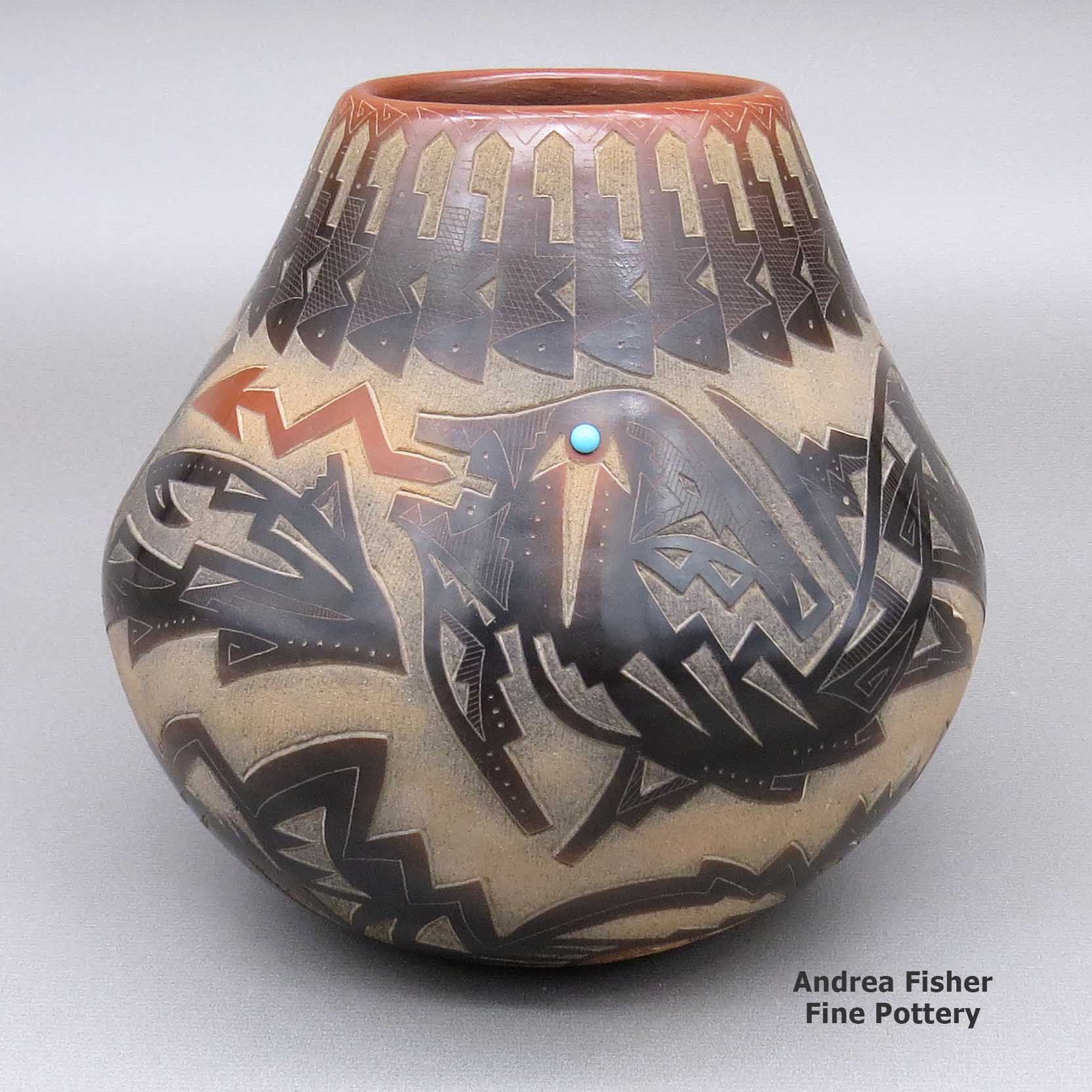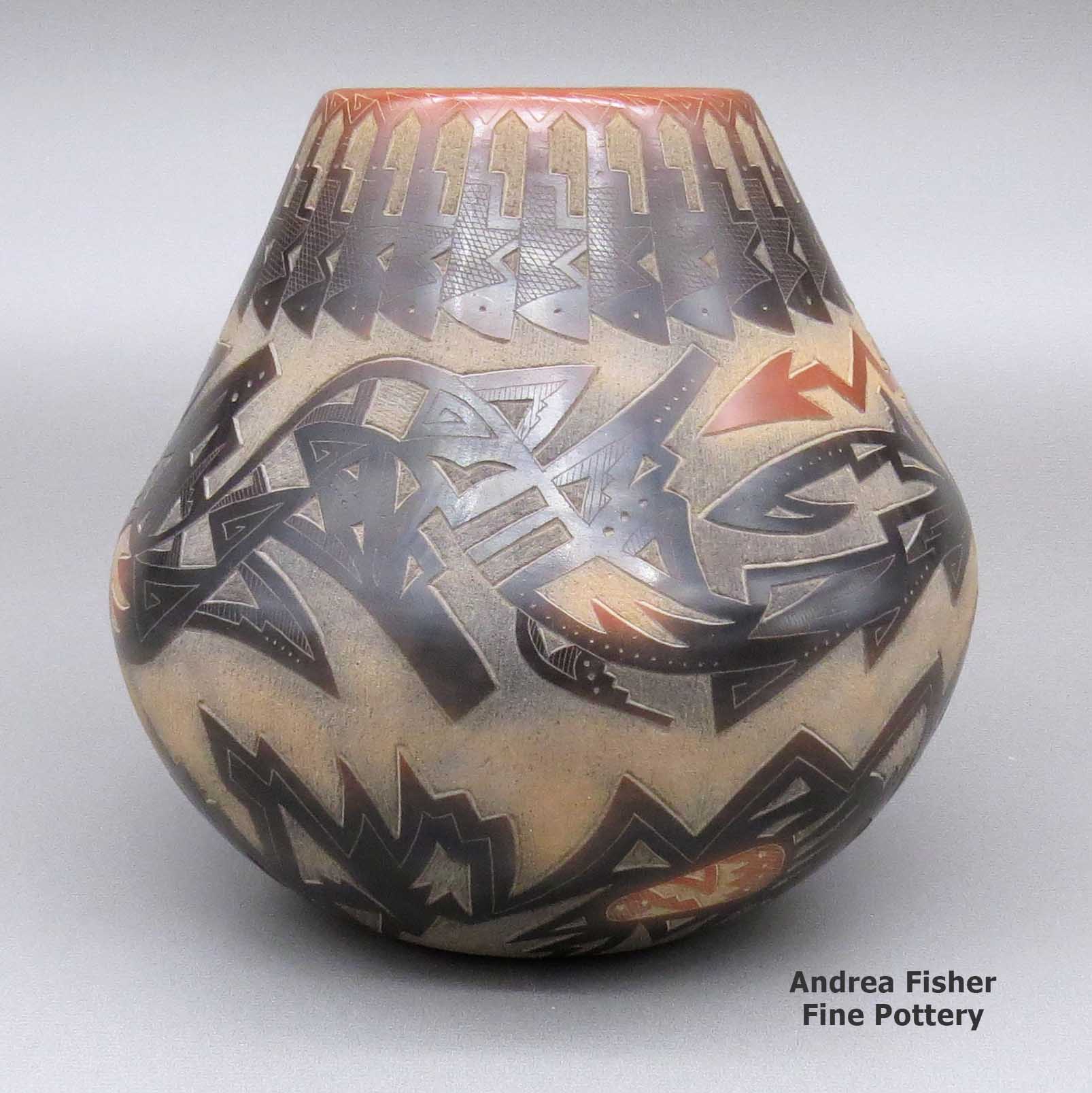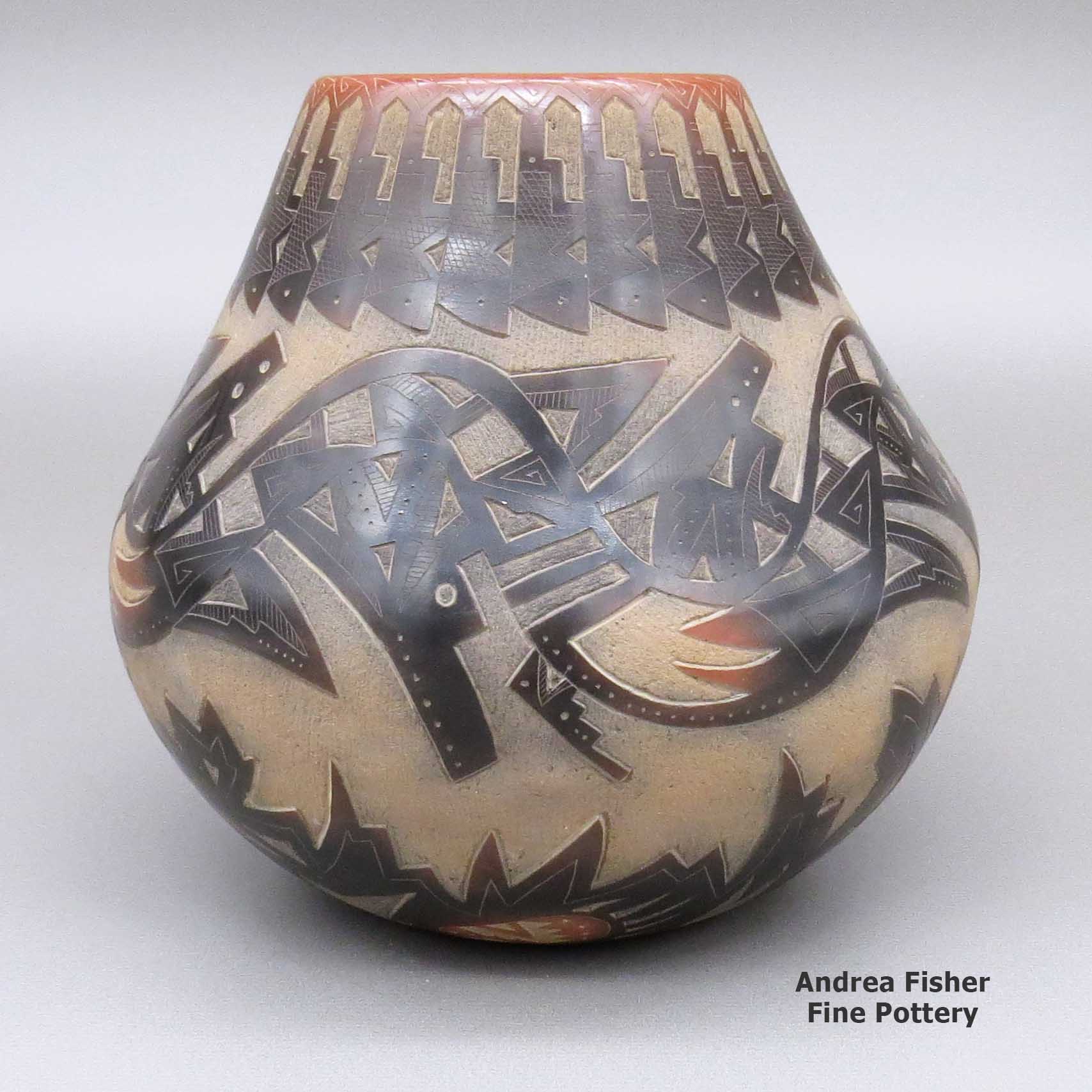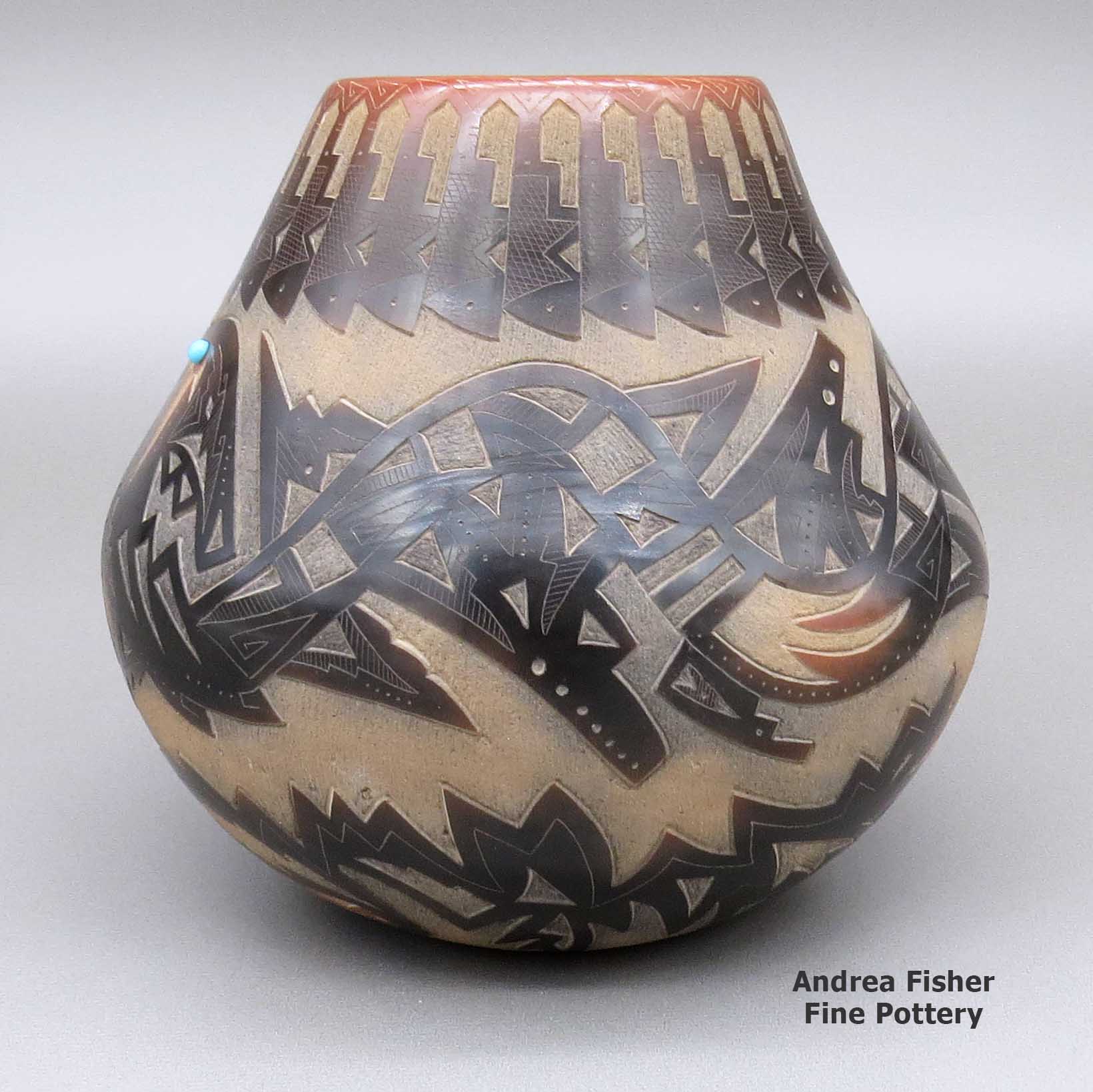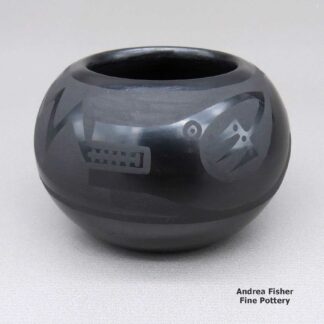| Dimensions | 5.75 × 5.75 × 5.75 in |
|---|---|
| Condition of Piece | Excellent |
| Date Born | 2023 |
| Signature | Sammy Naranjo Santa Clara Pueblo |
Sammy Naranjo, snsc3c075, Jar with an avanyu and geometric design
$825.00
A black jar with a sienna rim and spots, and decorated with a sgraffito avanyu, bear paw, ring-of-feathers, and geometric design, plus an inlaid turquoise detail
In stock
Brand
Naranjo, Sammy
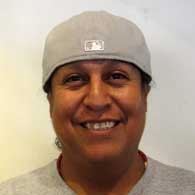 "My pottery is unique in the way that no other pot is the same. It is like the pottery is alive. It wants to be a certain way and no matter what I do it won’t change the outcome of what the pot wants to look like."
"My pottery is unique in the way that no other pot is the same. It is like the pottery is alive. It wants to be a certain way and no matter what I do it won’t change the outcome of what the pot wants to look like."Sammy Naranjo, (Okuwa Nae’ Khung Tsire, meaning: Dark Cloud Bird), was born into Santa Clara Pueblo in 1972. He is a member of the Tree Clan and is related to Barbara Martinez (birth mother), Flora Naranjo (mother), Glenda Naranjo (aunt), Vickie Martinez (sister) and Chris and Manuel Martinez (brothers).
Sammy tells us he was about twelve when his mother, Flora Naranjo, inspired him to create traditional carved pottery. Today, Sammy specializes in and is well known for his black and sienna jars decorated with finely executed sgraffito designs such as the avanyu (the mythic Tewa water serpent), feather patterns and bear paws.
Sammy gets his clay from a sacred place on Santa Clara Pueblo. He processes the clay himself, ridding it of impurities and preparing it for use. Then he builds a pot by hand coiling and shaping it, then by polishing it with stones. He fires his black pots the traditional way, outdoors with wood and horse manure.
In his words: "I enjoy making pottery because I like to come up with my own traditional designs. I also find that etching my pots is a challenging and rewarding experience. My pottery is unique in the way that no other pot is the same. It is like the pottery is alive. It wants to be a certain way and no matter what I do it won’t change the outcome of what the pot wants to look like."
Sammy has earned First and Second Place ribbons at the New Mexico State Fair, Eight Northern Indian Arts & Crafts Show and the Arizona State Museum.
He signs his work "Sammy Naranjo, Santa Clara Pueblo."
A Short History of Santa Clara Pueblo

Santa Clara Pueblo straddles the Rio Grande about 25 miles north of Santa Fe. Of all the pueblos, Santa Clara has the largest number of potters.
The ancestral roots of the Santa Clara people have been traced to ancient pueblos in the Mesa Verde region in southwestern Colorado. When the weather in that area began to get dry between about 1100 and 1300 CE, some of the people migrated to the Chama River Valley and constructed Poshuouinge (about 3 miles south of what is now Abiquiu on the edge of the mesa above the Chama River). Eventually reaching two and three stories high with up to 700 rooms on the ground floor, Poshuouinge was inhabited from about 1375 CE to about 1475 CE.
Drought then again forced the people to move. One group of the people went to the area of Puyé (along Santa Clara Canyon, cut into the eastern slopes of the Pajarito Plateau of the Jemez Mountains). Another group went south of there to what we now call Tsankawi. A third group went a bit to the north, following the Rio Chama down to where it met the Rio Grande and founded Ohkay Owingeh on the northwest side of that confluence.
Beginning around 1580, another drought forced the residents of the Puyé area to relocate closer to the Rio Grande. There, near the point where Santa Clara Creek merged into the Rio Grande, they founded what we now know as Santa Clara Pueblo. Ohkay Owingeh was to the north on the other side of the Rio Chama. That same dry spell forced the people down the hill from Tsankawi to the Rio Grande where they founded San Ildefonso Pueblo to the south of Santa Clara, on the other side of Black Mesa.
In 1598 Spanish colonists from nearby Yunqué (the seat of Spanish government near the renamed "San Juan de los Caballeros" Pueblo) brought the first missionaries to Santa Clara. That led to the first mission church being built around 1622. However, the Santa Clarans chafed under the weight of Spanish rule like the other pueblos did and were in the forefront of the Pueblo Revolt of 1680. One pueblo resident, a mixed black and Tewa man named Domingo Naranjo, was one of the rebellion's ringleaders.
When Don Diego de Vargas came back to the area in 1694, he found most of the Santa Clarans were set up on top of nearby Black Mesa (with the people of San Ildefonso, Pojoaque, Tesuque and Nambé). An extended siege didn't subdue them but eventually, the two sides negotiated a treaty and the people returned to their pueblos. However, successive invasions and occupations by northern Europeans took their toll on the pueblos over the next 250 years. The Spanish flu pandemic in 1918 almost wiped them out.
Today, Santa Clara Pueblo is home to as many as 2,600 people and they comprise probably the largest per capita number of artists of any North American tribe (estimates of the number of potters run as high as 1-in-4 residents).
For more info:Pueblos of the Rio Grande, Daniel Gibson, ISBN-13:978-1-887896-26-9, Rio Nuevo Publishers, 2001
Upper photo courtesy of Einar Kvaran, Creative Commons Attribution-Share Alike 3.0 Unported License
About Jars
The jar is a basic utilitarian shape, a container generally for cooking food, storing grain or for carrying and storing water. The jar's outer surface is a canvas where potters have been expressing their religious visions and stories for centuries.
In Sinagua pueblos (in northern Arizona), the people made very large jars and buried them up to their openings in the floors of the hidden-most rooms in their pueblo. They kept those jars filled with water but also kept smaller jars of meat and other perishables inside those jars in the water. It's a form of refrigeration still in use among indigenous people around the world.
Where bowls tend to be low, wide and with large openings, jars tend to be more globular: taller, less wide and with smaller openings.
For a potter looking at decorating her piece, bowls are often decorated inside and out while most jars are decorated only on the outside. Jars have a natural continuity to their design surface where bowls have a natural break at the rim, effectively yielding two design surfaces on which separate or complimentary stories can be told.
Before the mid-1800s, storage jars tended to be quite large. Cooking jars and water jars varied in size depending on how many people they were designed to serve. Then came American traders with enameled metal cookware, ceramic dishes and metal eating utensils...Some pueblos embraced those traders immediately while others took several generations to let them and their innovations in. Either way, opening those doors led to the virtual collapse of utilitarian pottery-making in most pueblos by the early 1900s.
In the 1920s there was a marked shift away from the machinations of individual traders and more toward marketing Native American pottery as an artform. Maria Martinez was becoming known through her exhibitions at various major industrial fairs around the country and Nampeyo of Hano was demonstrating her art for the Fred Harvey Company at the Grand Canyon. The first few years of the Santa Fe Indian Market helped to solidify that movement and propel it forward. It took another couple generations of artists to open other venues for their art across the country and turn Native American art into the phenomenon it has become.
Today's jars are artwork, not at all for utilitarian purposes, and their shapes, sizes and decorations have evolved to reflect that shift.
About the Avanyu
The avanyu is a mythical water creature likened to the feathered and plumed serpents of Mesoamerica. The design is primarily part of the design palette of Tewa potters from the Tewa Basin, and even there it varies by pueblo and artist. Wherever the artist is, the avanyu design generally represents the spirit of water rushing through a village after a downpour. The avanyu is also seen as the Keeper of Springs and Guardian of Water. The image is a prayer for rain with the realization of what a downpour can do when it falls on the hard soil of the arid and semi-arid Southwestern deserts.
Artists from San Ildefonso Pueblo generally use an avanyu design with a three-plumed head while Santa Clara Pueblo potters generally use an avanyu with three feathers hanging off the head. The avanyu always has a forked tongue, signifying the lightning bolts that herald its arrival. Some have simplified the design to one feather or plume while others have stylized the design and almost made it cubic or Oriental in design and layout.
Hopi-Tewa potters generally use a somewhat similar Hopi version of a flying, feathered serpent named kwataka. The Zuni version is Kolowisi, although it has been determined that the power of Kolowisi is too much for anyone who is not of Zuni descent so depictions of it have gotten almost as rare as depictions of kwataka.
Flora Naranjo Family Tree - Santa Clara Pueblo
Disclaimer: This "family tree" is a best effort on our part to determine who the potters are in this family and arrange them in a generational order. The general information available is questionable so we have tried to show each of these diagrams to living members of each family to get their input and approval, too. This diagram is subject to change should we get better info.
- Flora T. Naranjo & Ramon Naranjo
- Barbara Martinez
- Chris Martinez
- Vickie Martinez
- Sammy Naranjo & Adrianna Naranjo
- Sammy Naranjo & Melony Gutierrez
- Glenda Naranjo & Bruce Gibson
- Frances Naranjo Salazar & Jose H.R. Salazar
- Sophie Cata & Frank Cata (San Juan)
- Tricia Velarde
- Morgan Cata
- Pamela Cata
- Stacy Cata
- Angela Salazar
- Daniel Tafoya
- Keshia Tafoya
- Elaine Salazar
- Destiny Atkinson
- Monica Atkinson
- Jose Salazar
- Ronald Velarde
- Yolanda Velarde & James Moquino Sr.
- Keith Chavez
- Camille Moquino (1979-)
- Mario Thomas
- James Moquino Jr.
- Georgette Vigil
- Sophie Cata & Frank Cata (San Juan)
